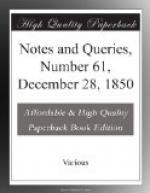The execution of Ravaillac was followed with the utmost exactness, but with more cruelty, if possible, in the case of Damiens (sentenced for the attempt on Louis le Bien-Aime), who suffered on the Place de Greve, March 28. 1757. The frightful business lasted from morning till dusk! Here again the knife was used before the body gave way, the horses having dragged at it for more than an hour first; the poor wretch living, it is said, all the while!
I believe this was the last instance of the punishment in France, if not in Europe.
A concise summary of the trials of these men, and all the hideous details of their tortures and execution, will be found, by those who have a taste for such things, in the third volume of the new series of the Neuer Pitaval, edited by Hitzig and Haring (Leipzig, Brockhaus),—a collection of causes celebres which has been in course of publication at intervals since 1842. The volume in question appeared in the present year (1850).
V.
Belgravia.
Vineyards (Vol. ii., p. 392.).—At Ingatestone Hall, in Essex, one of the seats of Lord Petre, a part of the ground on the south side of the house still goes by the name of “the Vineyard.” And this autumn grapes came to great perfection on the south wall.
J.A.D.
Cardinal (Vol. ii., p. 424.).—The expression referred to by O.P.Q. was in some degree illustrated at the coronation of Edward II., 1308, when the Pope, wishing the ceremony to be performed by a cardinal, whom he offered to send for the purpose, was strenuously opposed by the king, and compelled to withdraw his pretensions. (See Curtis’s History of England, vol. ii. p. 309.)
C.H.
St. Catherine’s Hall, Cambridge.
Weights for weighing Coins (Vol. ii., p. 326.).—If the question of your correspondent, who wishes to know at what period weights were introduced {523} for weighing coins, is intended to have a general reference, he will find many passages alluding to the practice amongst the ancient Romans, who manufactured balances of various kinds for that purpose: one for gold (statera auraria, Varro Ap. Non., p. 455., ed. Mercer.; Cic. Or. ii. 38.); another for silver (Varro De Vit. P.R. lib. ii.); and another for small pieces of money (trutina momentana pro parva modicaque pecunia. Isidor. Orig., xvi. 25. 4.). The mint is represented on the reverse of numerous imperial coins and medals by three female figures, each of whom holds a pair of scales, one for each of the three metals; and in Rich’s Illustrated Companion to the Latin Dictionary, under the word LIBRA, there is exhibited a balance of very peculiar construction, from an original in the cabinet of the Grand Duke at Florence, which has a scale at one end of the beam, and a fixed weight at the opposite extremity, “to test the just weight of a given quantity, and supposed to have been employed at the mint for estimating the proper weight of coinage.”




